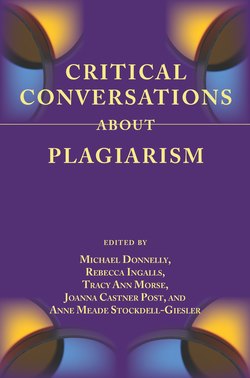Читать книгу Critical Conversations About Plagiarism - Michael Donnelly - Страница 8
На сайте Литреса книга снята с продажи.
ОглавлениеPart I
Definitions of Plagiarism:
Distinctions, Laws, and Rules
In most discussions, the definition of plagiarism is assumed to be obvious to all. Most composition textbooks, especially those that deal with research writing, contain sections on plagiarism and appropriate citation of sources. Virtually every writing “handbook,” a staple of the first-year writing course, does the same. In most cases, these texts offer a simple one- or two-sentence definition, as if plagiarism is really a simple matter—agreed upon by all—and easily avoided by the use of proper citation. Few offer more in terms of critical discussion or even indicate that there is disagreement over what plagiarism is.
The fact is—there is no one simple definition of plagiarism that works clearly and effectively for all cases. Consider, for example, the following definitions provided by three different writing handbooks:
“Plagiarism is understood to be a writer’s deliberate misrepresentation of another’s writing or ideas as his or her own” (Blakesley and Hoogeveen 358).
Researchers who fail to acknowledge their sources—either intentionally or unintentionally—commit plagiarism. Buying a term paper from an online paper mill or “borrowing” a friend’s completed assignment are obvious forms of plagiarism. But plagiarism also includes paraphrasing or summarizing material without properly citing its source. (Maimon, Peritz, and Yancey 265)
“Plagiarism is defined as the unauthorized or misleading use of the language and text of another author” (Hult and Huckin 142).
Each of these definitions is, basically, as good as any other, but notice the differences in the territory they do and do not cover. One specifically states that plagiarism is the “deliberate misrepresentation of another’s writing or ideas” (emphasis added), while the next says “either intentionally or unintentionally,” and the third makes no reference at all to the writer’s intent. Further, the second identifies the failure to cite sources as the defining feature; yet, one might acknowledge a source and still misrepresent “another’s writing or ideas as his or her own”; conversely, one might not “misrepresent” another’s writing, yet fail to properly cite the source. The third definition is murkier still. What does “unauthorized” use mean? Do I need the author’s permission to cite her work? What does “misleading” mean here? This definition also specifies use of only the “language and text,” while the first definition specifies “writing or ideas” (emphasis added), and the second includes ideas only when they are expressed through paraphrasing and summarizing.
The issue is among those that are so troublesome and so central to the teaching of writing that the Council of Writing Program Administrators, the national organization of those who oversee various types of writing programs and writing centers, was compelled in 2003 to issue a Statement on Best Practices with regard to “Defining and Avoiding Plagiarism.” While the statement acknowledges that “[i]n instructional settings, plagiarism is a multifaceted and ethically complex problem,” it then goes on to provide a simple, one-sentence definition: “In an instructional setting, plagiarism occurs when a writer deliberately uses someone else’s language, ideas, or other original (not common knowledge) material without acknowledging its source.” Since then, scholars in composition studies have begun to explore more fully, rather than assume, conflicting definitions and their relationship to the processes of learning to write, as well as to a number of critical, related concepts like originality, identity, authorship, ownership, and context. Martha Vicinus and Caroline Eisner’s Originality, Imitation, and Plagiarism: Teaching Writing in the Digital Age; Rebecca Moore Howard and Amy Robillard’s Pluralizing Plagiarism: Identities, Contexts, Pedagogies; Carol Peterson Haviland and Joan A. Mullin’s Who Owns This Text?: Plagiarism, Authorship, and Disciplinary Cultures—these and others have called simplistic definitions of plagiarism into question and complicated our understanding of the issues. Like them, the authors collected here in Part I do not assume a single, fixed definition of plagiarism. Instead, they consider the issue of definition by examining how perceptions of plagiarism often differ; how the concept of plagiarism relates to other concepts like copyright law, on the one hand, and artistic or creative “borrowing,” on the other; and how notions of plagiarism are tangled up in the process of learning to write in academic contexts.
Plagiarism is a complicated concept, one that has much to do with cultural notions of authorship and the ownership of both language and ideas, and it functions in a variety of sometimes contradictory and often mysterious ways. It is not something that can be avoided simply, the way one might avoid speeding by keeping an eye on the speedometer. Understanding plagiarism is, therefore, a complex process—one that requires deep, critical thinking and discussion about writing, about developing one’s own ideas while responding to and incorporating the ideas of others.
Works Cited
Blakesley, David, and Jeffrey L. Hoogeveen. The Thomson Handbook: Preview Edition. Boston, MA: Thomson Wadsworth, 2007. Print.
Council of Writing Program Administrators. “Defining and Avoiding Plagiarism: The WPA Statement on Best Practices.” January 2003. Web. 1 February 2010.
Haviland, Carol Peterson, and Joan A. Mullin, eds. Who Owns This Text?: Plagiarism, Authorship, and Disciplinary Cultures. Logan: Utah State UP, 2008. Print.
Howard, Rebecca Moore, and Amy Robillard, eds. Pluralizing Plagiarism: Ideas, Contexts, Pedagogies. Portsmouth, NH: Boynton/Cook, 2008. Print.
Hult, Christine A., and Thomas N. Huckin. The Brief New Century Handbook. 2nd ed. New York: Pearson Longman, 2004. Print.
Maimon, Elaine P., Janice H. Peritz, and Kathleen Blake Yancey. A Writer’s Resource: A Handbook for Writing and Research. 2nd ed. Boston, MA: McGraw-Hill, 2007. Print.
Vicinus, Martha, and Caroline Eisner, eds. Originality, Imitation, and Plagiarism: Teaching Writing in the Digital Age. Ann Arbor: U of Michigan P, 2008. Print.
